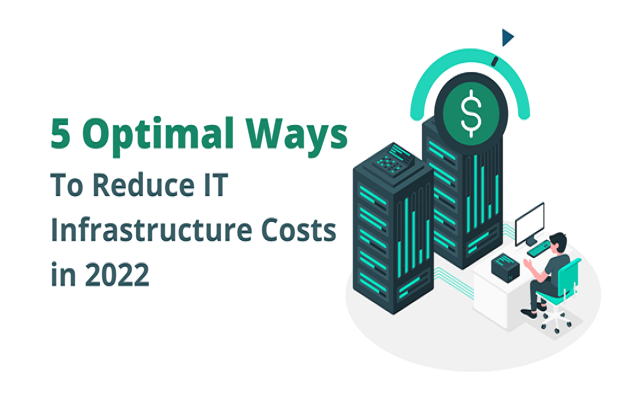A constant need for relevancy among businesses leads to increased pressure on IT managers to push infrastructure boundaries. As a result, increased userbase, innovative integrations, and lower productivity have led to higher IT infrastructure costs. Several factors affect the cost of IT infrastructure, security, cooling, power consumption, physical hardware, etc.
According to a report, if an organization employs more than 2500 people, they will have to spend an average of $5000 per year for each computer system deployed. So, there is no denying that you need a strategy to reduce IT infrastructure costs and curb the spending spiraling out of hand.
Here we will discuss some of the top ways to reduce IT infrastructure costs for your organization.
#1. Manage the physical infrastructure costs
Physical infrastructure contributes to a high cost of the entire IT budget. In addition, it requires constant monitoring to realize the need for a hardware refresh, additional servers, performance bottlenecks, etc.
The server is the heart of physical infrastructure. So, it becomes essential to optimize server performance to reduce costs. According to ZDNet, the average cost of running one server can be around $731.94 annually.
So, what’s the optimal way to reduce server costs?
Virtualization is one of the best ways to optimize server performance and reduce costs. It allows organizations to create abstract layers in the infrastructure. So, you can have multiple virtual servers or machines without increasing physical capacity. Virtual machines allow you to isolate resources like RAM, processor, storage, and network through the hypervisor.
#2. Move from Capex to Opex
Capex or capital expenditure is an upfront investment needed to run the systems. One of the significant Capex is infrastructure planning and installation. IT managers must review everything from servers, storage planning, installation design, and scaling needs before the procurement process.
It means upfront costs of research, analysis, procurement, and installations. So, before your system runs even a single minute, it incurs massive Capex.
This is where you need to move your IT infrastructure from Capex to Opex. An easy way is to choose an infrastructure service that provides a pay-as-you-go model. So, there are no upfront costs. Companies can also select a subscription-based service with fixed monthly expenses.
Cloud services offer a pay-per-you-go model that allows organizations to reduce IT infrastructure costs. For example, you can use AWS EC2 instances per hour for your apps and software. The best thing about such instances is that you can terminate them without need. So, you don’t have to pay for idle resources.
Similarly, several cloud services offer IT infrastructure services with a pay-as-you-go model. For example, the shift from Capex to Opex is cost-effective as you are not spending upfront but paying according to operations. However, the pricing model is not the only reason for cloud migration.
#3. Migrate to cloud
Cloud migration is an approach that encapsulates the idea of moving from Capex to Opex. It incurs migration costs upfront, but a significant chunk is operating expenses. So, there is no denying that you can reduce the Capex through cloud migration; Opex still needs optimization.
So, you need to plan cloud migration and cost optimization simultaneously. The first step toward cloud cost optimization is an assessment of your current IT infrastructure. Once you analyze the existing infrastructure, create a requirement plan.
Finally, compare different cloud services according to the requirement plan, pricing, and compatibility with existing infrastructure. Then, select the right cloud service vendor according to comparison and devise a migration plan.
Organizations use different approaches to go cloud. While some use a hybrid approach, others choose to migrate entirely to the cloud. The hybrid approach has specific challenges of IT infrastructure costs.
#4. Optimize the hybrid cloud
Optimization is key to reducing costs if you use an on-premise data center and cloud services in a hybrid approach. Most organizations use an on-premise data center for core services and a cloud service for customer-facing apps. However, choosing a hybrid approach for your apps does not guarantee cost-effectiveness.
According to the state of hybrid cloud 2021, 45% of respondents repatriated back to on-premise data centers due to hidden costs of public cloud services. So, if you are already using a hybrid approach, here are some tips to optimize IT infrastructure costs,
●Idle service optimization by identifying and deactivating the underutilized cloud services
● Estimate resource usage for projects and ideate the budget alignment through research.
● Understand the cloud service pricing structure to optimize costs
●Provision of workloads according to priority for optimal usage of resources
●Use role-based access control (RBAC) to reduce the costs of data security
●Leverage data visualizations through heat maps and other analytics to reduce downtime
Lastly, IT infrastructure cost optimization needs a sustainable system.
#5. Build a sustainable infrastructure
Operational costs for servers also include power consumption and cooling requirements. Therefore, infrastructures are built for maximum power consumption to cope with performance needs.
According to research, an IT infrastructure system consumes power from 500KW to 2MW during peak loads. On the other hand, such infrastructure's cooling requirements increase power consumption. As a result, the overall power consumption due to cooling systems is between 750KW and 2.5MW.
So, how to reduce the costs of power consumption?
The best way to optimize server operation costs is to use “Energy-Proportional Computing.” It is an approach where you grow infrastructure as per need reducing the overhead costs of additional capacity. In other words, you can increase the infrastructure capacity as you scale.
Conclusion
In the age of rapid digital transformations and digitizations, the only thing that keeps increasing consistently is data. So, if you don’t have a strategy and planned infrastructure, the cost of operations will increase. As discussed, there are multiple ways to reduce IT infrastructure costs. However, which one to use depends on your business-specific requirements.

No comments:
Post a Comment